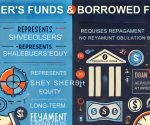Gap Generally Accepted Accounting Principles (GAAP) are the foundation of financial accounting and reporting in the United States. These principles standardize the preparation and presentation of financial statements, ensuring consistency, transparency, and comparability across businesses. Established by regulatory bodies like the Financial Accounting Standards Board (FASB), GAAP compliance is essential for organizations to maintain trust with stakeholders and adhere to legal requirements. Understanding its principles and differentiating it from other frameworks, such as IFRS, is key for global commerce.
What Are Generally Accepted Accounting Principles?
Generally Accepted Accounting Principles (GAAP) are a set of rules and standards that govern how financial transactions are recorded and reported. These principles aim to ensure the accuracy and consistency of financial statements, providing a reliable basis for comparison and analysis.
Core Objectives
- Consistency: Enables stakeholders to compare financial data across periods and companies.
- Relevance: Ensures financial information aids decision-making.
- Transparency: Builds trust through clear and standardized disclosures.
Key Principles
- Revenue Recognition Principle: Revenue is recognized when earned, not when received.
- Matching Principle: Expenses are matched with related revenues.
- Full Disclosure Principle: All relevant financial information must be disclosed.
Generally Accepted Accounting Principles (GAAP)
GAAP is a standardized set of rules and guidelines on financial accounting and reporting. GAAP ensures consistency, transparency, and comparability in statements, so it becomes easier for investors, stakeholders, and regulators alike to understand and evaluate a company’s financial performance. These principles encompass one’s revenue recognition, matching expenses, and the principle of full disclosure among many others and can be considered a basis for proper and fair financial practices.
Components of GAAP
- Principles: Provide the framework for financial reporting.
- Standards: Define specific requirements for accounting issues (e.g., lease accounting).
- Assumptions: Underpin financial reporting, such as the going concern assumption.
- Constraints: Include cost-benefit analysis to ensure practicality.
GAAP in Practice:
| Area | GAAP Standard | Example |
| Revenue Recognition | ASC 606 | Revenue recognized upon performance obligations. |
| Inventory Valuation | FIFO or LIFO | Choice of method impacts reported earnings. |
| Depreciation | Straight-line or accelerated methods | Affects asset valuation and expense reporting. |
GAAP Compliance
GAAP Compliance refers to the compliance with Generally Accepted Accounting Principles, standardized guidelines for financial reporting, which ensure consistency, transparency, and accuracy in the financial statements, thus promoting trust from stakeholders and adherence to the requirements of the regulatory authorities.
Steps to Ensure Compliance:
- Understand Requirements: Stay updated with FASB standards.
- Accurate Record-Keeping: Ensure transactions are documented as per GAAP principles.
- Regular Audits: Conduct internal and external audits to verify adherence.
- Continuous Training: Educate staff on changes in GAAP standards.
- Benefits of Compliance: Facilitates access to capital markets. Enhances stakeholder trust. Reduces legal and regulatory risks.
- Challenges: Complexity of updates and amendments. High costs of implementation and audits.
Difference Between GAAP and IFRS
While GAAP is primarily used in the United States, the International Financial Reporting Standards (IFRS) are widely adopted globally.
| Aspect | GAAP | IFRS |
| Scope | U.S.-centric | International |
| Regulatory Body | FASB | International Accounting Standards Board (IASB) |
| Revenue Recognition | More prescriptive rules | Principle-based approach |
| Inventory Valuation | Allows LIFO | Prohibits LIFO |
Insights: GAAP provides detailed guidelines, while IFRS focuses on broader principles. IFRS adoption may benefit multinational corporations by standardizing reporting across jurisdictions.
Conclusion
GAAP Generally Accepted Accounting Principles form the cornerstone of financial reporting in the U.S., ensuring consistency, transparency, and reliability in financial statements. While its compliance demands rigorous effort and resources, the benefits outweigh the challenges, fostering trust among stakeholders and facilitating sound financial decision-making. Differentiating GAAP from frameworks like IFRS is crucial for companies operating in global markets. Staying informed and aligned with GAAP standards will continue to be essential in a dynamic financial landscape.
GAAP Generally Accepted Accounting Principles FAQs
What is the primary goal of GAAP?
GAAP aims to standardize financial reporting, ensuring consistency and reliability for stakeholders.
Who regulates GAAP in the U.S.?
The Financial Accounting Standards Board (FASB) regulates GAAP, with oversight from the SEC.
How does GAAP differ from IFRS?
GAAP is rules-based and U.S.-centric, while IFRS is principle-based and globally adopted.
Why is GAAP compliance important?
Compliance builds stakeholder trust, facilitates market access, and ensures legal adherence.
What is the role of the revenue recognition principle in GAAP?
It ensures revenue is recorded when earned, providing an accurate financial picture.


